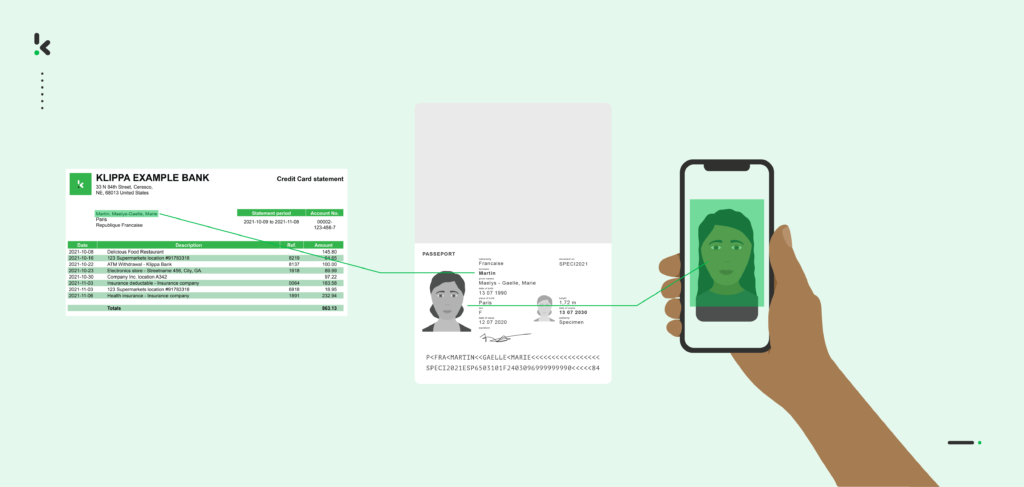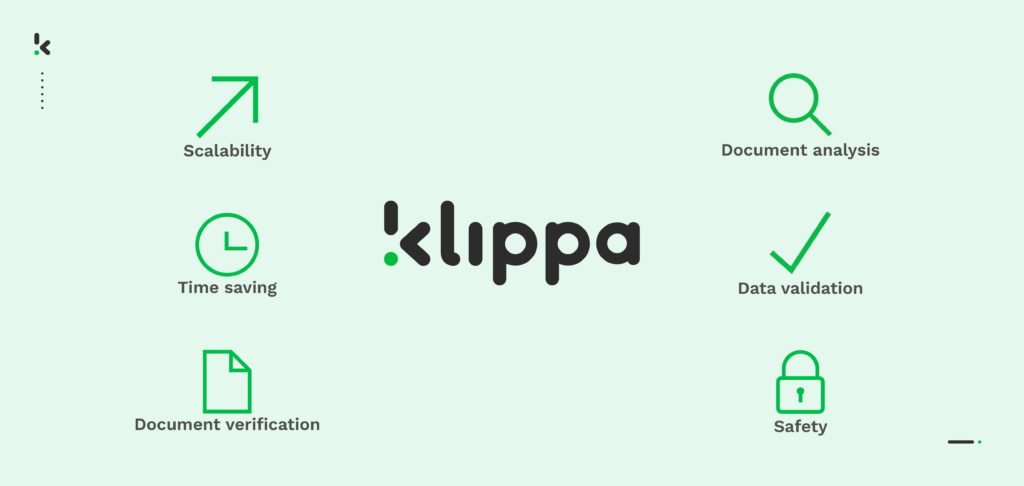

The real estate sector is one of the most important economic sectors. As a matter of fact, in 2024, it was valued at 4.1 trillion dollars worldwide, and is expected to reach 5.82 trillion by 2030. Such significant amounts of money attract fraudsters and other criminals, who are often involved in money laundering or terrorism financing.
In order to prevent money laundering through real estate and protect the industry, Know Your Customer (KYC) and Anti-Money Laundering (AML) controls are mandatory under AML regulations. They are created to ensure that the money invested is traceable and not derived from criminal means.
To make your KYC & AML processes more secure and efficient, several Intelligent Document Processing (IDP) solutions have been developed. IDP solutions are able to conduct automated data extraction, document verification, fraud detection, and data masking, which help you save time and money.
In this blog, we will clarify how money is laundered through real estate, discuss AML and KYC regulations per region, and explain how automated KYC software can protect your company from financial fraud.
Key Takeaways
- Real estate is highly vulnerable to money laundering due to high-value transactions and anonymous ownership structures.
- KYC and AML regulations are legally required to verify identities and trace the source of funds in property deals.
- Regional rules differ, but all involve multi-document verification, making manual checks slow and risky.
- Automated KYC software helps real estate firms stay compliant, reduce fraud, and speed up onboarding at scale.
How is Money Laundered Through Real Estate?
Real estate is one of the most frequently exploited sectors for money laundering. In fact, the Financial Action Task Force (FATF) estimates that over US$1.6 trillion is laundered through global property markets each year – a figure that highlights just how deeply criminal networks infiltrate this sector.
Why is real estate so attractive to money launderers? Because property can conceal the source of illicit funds while offering long-term value and legitimacy. The process is often subtle, masked by legal transactions that make tracing origins difficult.
Below are three of the most common tactics used to launder money through real estate:
Cash Payments
It is important to ensure that not all cash payments are fraudulent. But keep in mind that cash payments are one of the most common ways to launder money because fraudsters can hide behind a legitimate way of paying. Also, with cash payments or deposits, it’s very difficult to track the origin of the money.
Typically, launderers break large amounts into smaller deposits across multiple banks (known as smurfing) to avoid detection. Once deposited, these funds are used to purchase real estate, giving the money a legitimate appearance.
Property Price Manipulation
Property price manipulation is another way to launder money. This is typically done by artificially enhancing real estate value with renovations. This leads to an overestimation and overvaluation of the property to get a higher mortgage from a bank.
How does it work? A house buyer asks for a loan. In order to receive a bigger loan and launder money, they’ll increase the amount of money needed to renovate the house. To do so, they can either alter an existing invoice or work with fraudulent companies to create corrupted invoices.
By artificially increasing the value of a real estate property, fraudsters can receive a significant amount of money.
Let’s say someone buys a house costing €300,000 that requires €15,000 of renovation. Deliberately, they overestimate the cost of renovation and declare an amount of €50,000. Then, the bank grants a larger loan, and the difference between the loan and the actual price of the renovation is a fraud.
Unclear Ownership Structure
A company’s ownership structure states who owns the company, who its legal representatives are, and who can be held responsible for any criminal acts. It also states the identity of each individual having a financial interest in the company. This chart, part of the company registration, is mandatory and has to be as clear as possible.
A company’s ownership structure can be useful in any case of investigation or questioning about the company. It can be used to find out where money is coming from and if its origin is legal. To hide their ownership and divert attention from themselves, fraudsters often build an unclear, complex ownership structure.
This list of examples of money laundering is not exhaustive. There are many different ways in which fraudsters launder money. To prevent and detect these kinds of fraud, you can strengthen your KYC and AML controls. The following section introduces the different regulations in three different areas: Europe, the US, and the UK.
AML and KYC Regulations in the Real Estate Sector
To prevent money laundering and terrorism financing, most countries now require real estate firms to comply with strict AML (Anti-Money Laundering) and KYC (Know Your Customer) regulations. These laws ensure that every buyer’s identity, source of funds, and ownership structure are verified before a transaction is approved.
The goal is simple: stop criminals from using property to legitimize illicit wealth. While the core requirements are similar (ID verification, proof of residence, due diligence), the rules vary across regions. In the next section, we’ll break down how KYC and AML are applied in the EU, US, and UK real estate markets.
KYC Regulations and Practices Per Region
KYC requirements vary by jurisdiction, but the goal is the same: verify the identity and legitimacy of every party in a real estate transaction. Here’s how KYC is enforced across the EU, the United States, and the United Kingdom as of 2025:
Europe
In the European KYC regulations, an identity document containing a picture of the recipient is required. It is up to the country to decide which documents are considered ID documents and if an additional document is required. For most countries, it can be a passport, a national ID card, or a driving license. This is required to prove the identity of the individual.
A KYC authentication also requires Proof of Residence from the recipient. Many documents can be used as such. Examples are utility bills, rental agreements, bank statements, and payslips. In most cases, they must be less than three months old. All European regulations can be found in the Fifth Anti-Money Laundering Directive.
United States
In the US, the authority in place is the Financial Crimes Enforcement Network, also called FinCEN. They set out the rules and regulations for KYC checks.
Like in Europe, US recipients must prove their identity with an ID document containing a picture. The same list of documents goes here: passport, ID card, and driving license.
On top of that, one of the most important documents and sources of identification in the US is the Social Security Card. This document is also required among the KYC documents asked for by the recipient.
There are three layers of KYC requirements in the US:
- Customer Identification Program (CIP): The CIP requires customers to provide four pieces of identifying information: full name, date of birth, address, and social security number. The CIP always applies, irrespective of the risk profile.
- Customer Due Diligence (CDD): CDD is a series of background checks and other screenings on clients to verify a client’s identity and assess their risk profiles. By law, CDD is a required procedure for all financial institutions before onboarding new clients.
- Enhanced Due Diligence (EDD): EDD is only used for clients with a higher risk of infiltration, terrorist financing, or money laundering, and additional information gathering is often required.
United Kingdom
The KYC regulation in the UK is tighter than in most European countries or the US. Basically, it starts with the same obligations, such as knowing who the potential recipient is. The required documents are all regular government-issued ID documents.
It is stricter because the recipient has to prove the source of their funding and express their activities. This is done by providing salary slips, bank statements, and tax statements.
AML Regulations in Real Estate
Anti-Money Laundering (AML) regulations go beyond basic identity checks to trace the true origin of funds involved in real estate transactions. These controls are especially critical in property deals due to the high transaction values and risk of abuse through shell companies or cash deals.
For example, in France, banks must verify a client’s identity and request supporting documents like pay slips, tax statements, and bank records. Since 2015, French authorities have also capped cash payments at €3,000 to curb anonymous transactions.
In the United Kingdom, real estate agencies are required to register with HMRC, which monitors AML compliance. Agents must assess a buyer’s income and apply transaction thresholds to flag potential laundering attempts, especially in high-value or cash-based deals.
With regulatory pressure mounting and documentation requirements growing, manual compliance processes are no longer sustainable.
In the next section, we’ll explore how real estate companies can streamline KYC and AML checks with automation.
How to Stay Compliant with KYC & AML


Meeting KYC and AML requirements manually is time-consuming, error-prone, and difficult to scale. Every new client brings multiple documents to verify (identity cards, proof of address, income records, tax data), and doing this manually not only slows down onboarding but also increases the risk of human error or non-compliance.
That’s why more real estate companies are turning to automated KYC software. These tools handle identity verification, document checks, and fraud detection within seconds, freeing up staff and ensuring consistent compliance with local regulations.
With automation, you can onboard clients faster, reduce costs, and minimize legal risk. It also enables you to scale your operations while maintaining full transparency and control over every transaction.
Next, we’ll look at how automated KYC and AML validation works and how it can be implemented in your real estate business.
Start Automating Your KYC/AML Process
By automating your KYC/AML verification, you can verify all the documents needed according to local regulations. You can use KYC software to automatically verify passports, ID cards, driving licenses, and even residence permits or social security cards.
On top of that, depending on the KYC software you decide to use, additional security layers can be added. For instance, biometric or selfie verification makes your ID verification even more accurate and secure.
Biometric verification is the act of using unique physical characteristics to identify an individual, such as fingerprints or facial characteristics. Selfie verification uses a picture of the individual and compares it to the picture on the ID document or a previously stored selfie.


The main reasons for using such software are cost reduction, improved processing speed, and increased accuracy of identity verification. And, of course, being GDPR compliant with the ability to mask sensitive information or only process the required information.
In order to comply with KYC and AML regulations, real estate companies need efficient KYC automation software. In the next section, you will be introduced to Klippa’s KYC software and see how exactly it can streamline and secure your verification process.
What to Expect from Klippa’s KYC Software
Klippa’s KYC solution is built to streamline identity verification and AML compliance for real estate businesses operating at scale. Whether you’re onboarding local clients or international investors, our platform offers fast, secure, and fully automated checks, helping you stay compliant without slowing down operations.
With support for ID documents from over 200 countries, Klippa’s software can verify passports, national IDs, driver’s licenses, residence permits, and more. For enhanced security, we offer advanced features like:
- Selfie Verification: Users take a live photo, which is matched to their ID document using AI-powered facial comparison.
- Biometric Verification: Use facial features to verify identity, enabling secure, frictionless onboarding.
- Liveness Detection: Ensure the user is physically present and not using a spoofed image.
- Optical Character Recognition (OCR): Extract data with up to 99% accuracy, reducing manual input and error.
Our system is GDPR compliant, and no sensitive data is stored – only extracted and securely transferred. You can integrate Klippa’s KYC engine into your existing software stack or connect it to external sources like PEP and sanctions lists, making background checks seamless.
Whether you’re verifying buyers for residential listings, screening foreign investors in commercial deals, or onboarding high volumes of tenants and landlords, Klippa’s KYC software helps real estate businesses stay compliant with AML laws quickly and securely.
Do you want to automate your KYC or AML process for your real estate business? Book a demo with one of our product experts via the form below, or contact us directly.
FAQ
KYC helps real estate firms verify the identity of clients and prevent money laundering, fraud, or financing of illegal activities. It’s a legal requirement in many jurisdictions.
Most KYC processes require a valid government-issued photo ID (passport, ID card, or driver’s license), proof of address (utility bill, bank statement), and sometimes proof of income or source of funds (tax statements, payslips).
KYC is a subset of AML. KYC focuses on verifying a client’s identity, while AML encompasses broader practices to detect and report suspicious financial activity.
For a more detailed breakdown of how KYC and AML differ, check out our full guide.
Automated KYC software uses OCR, biometric checks, and document verification to validate client identities in real time. It reduces manual effort, speeds up onboarding, and helps meet regulatory requirements.
It’s not mandatory everywhere, but biometric and selfie verification are becoming best practices, especially for high-value or remote transactions, to prevent identity fraud.
Klippa provides automated KYC and AML tools designed for real estate workflows. It verifies global ID documents, supports biometric and selfie checks, and integrates with external AML databases for enhanced due diligence.